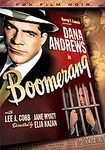Small town Connecticut. A beloved priest is gunned down in the middle of a busy street, and the pressure is on for the police to find the killer. The new regime at city hall needs a conviction, and doesn’t care too much about the niceties. When a suspect (Arthur Kennedy) is at last found, police chief Lee J. Cobb isn’t entirely happy with the case, but he passes it on to DA Dana Andrews, who is under even more political pressure. At first pleased with the case, Andrews becomes uncertain the more he looks into it, and startles everyone (not least the defence attorney) by entering a plea of innocent at the beginning of the trial. Politicians and lynch mobs are soon baying at his door.
Elia Kazan’s 1947 thriller is, as commentators Alain Silver and James Ursini point out, very much in the vein of the docu-noir. There is lots of procedural action going on here, and the voice-of-god narrator is frequently on hand to explain things to us. What is perhaps most interesting about the film, though, is that the case itself becomes of secondary importance to the political machinations. This isn’t so much about the possible conviction of an innocent man, so much as it is about the mechanisms that make such a thing possible in the first place. Given what the future would hold for Kazan and his involvement with the HUAC hearings, the witch hunt scenes here take on additional, troubling, resonance.
Audio
As is often the case, both stereo and original mono options are available here. The stereo has a nice, rich quality, and the dialogue is distortion-free, so the listening experience is generally pleasant. There is at least one instance of static, but otherwise the track is very clean. The usual problem of wraparound dialogue is present, though. While not enough to be distracting, at least not in the long run, it is there, so viewers might well prefer to stick to the mono.
Video
The print is in very nice shape, though it isn’t completely flawless. While much of the running time is almost completely free of blemishes, once or twice there are some guitar strings marring the frame. The grain is minimal, though not entirely absent, and there is a bit of edge enhancement visible too. Still, the stark black-and-white tones are beautifully rendered, and by and large this is a pretty damn nice transfer.
Special Features
Film noir perennials Alain Silver and James Ursini are back, with another lively and informative commentary track, situating the film not only within the context of other noirs, but specifically with respect to Kazan’s career (on that note, watch for a young Karl Malden in a small role as one of Cobb’s men). The poster gallery, unit photography gallery and theatrical trailer are also along for the ride.
Closing Thoughts
A fine mix of drama and thriller, with a strong political bounce not often seen in films of this type.






